
A bus is a road vehicle designed to carry many passengers. Buses can have a capacity as high as 300 passengers. The most common type is the single-deck rigid bus, with larger loads carried by double-decker and articulated buses, and smaller loads carried by midibuses and minibuses while coaches are used for longer-distance services. Many types of buses, such as city transit buses and inter-city coaches, charge a fare. Other types, such as elementary or secondary school buses or shuttle buses within a post-secondary education campus do not charge a fare. In many jurisdictions, bus drivers require a special licence above and beyond a regular driving licence.
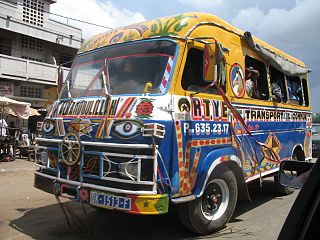
A share taxi is a mode of transport which falls between a taxicab and a bus. These vehicles for hire are typically smaller than buses and usually take passengers on a fixed or semi-fixed route without timetables, but instead departing when all seats are filled. They may stop anywhere to pick up or drop off their passengers. Often found in developing countries, the vehicles used as share taxis range from four-seat cars to minibuses. They are often owner-operated.
Compressed natural gas is a fuel gas made of natural gas, which is mainly composed of methane (CH4), compressed to less than 1% of the volume it occupies at standard atmospheric pressure. It is stored and distributed in hard containers at a pressure of 20–25 MPa (2,900–3,600 psi), usually in cylindrical or spherical shapes.
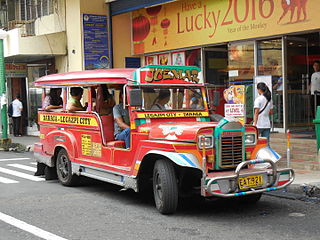
Jeepneys, sometimes called simply jeeps, are buses and the most popular means of public transportation ubiquitous in the Philippines. They are known for their crowded seating and kitsch decorations, which have become a widespread symbol of Philippine culture and art. A Sarao jeepney was exhibited at the Philippine pavilion at the 1964 New York World's Fair as a national image for the Filipinos.

A minibus, microbus, minicoach, or commuter is a passenger-carrying motor vehicle that is designed to carry more people than a multi-purpose vehicle or minivan, but fewer people than a full-size bus. In the United Kingdom, the word "minibus" is used to describe any full-sized passenger-carrying van or panel truck. Minibuses have a seating capacity of between 8 and 30 seats. Larger minibuses may be called midibuses. Minibuses are typically front-engined step-entrance vehicles, although low floor minibuses do exist and are particularly common in Japan. Minibuses may range in price from £2000 to nearly £100,000.
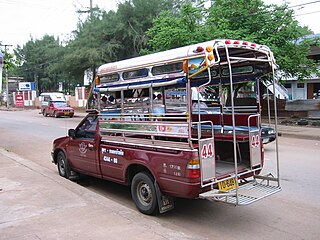
A songthaew is a passenger vehicle in Thailand and Laos adapted from a pick-up or a larger truck and used as a share taxi or bus.
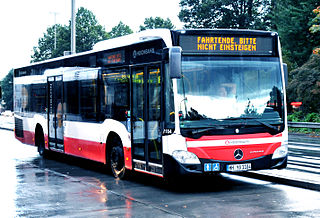
Mercedes-Benz has been producing buses since 1895 in Mannheim in Germany. Since 1995, the brand of Mercedes-Benz buses and coaches is under the umbrella of EvoBus GmbH, belonging 100% to the Daimler AG.

Colectivo is the name given in Argentina, Colombia, Chile and Paraguay to a type of public transportation vehicle, especially those of Argentina's capital city, Buenos Aires. The name comes from vehículos de transporte colectivo, reflecting their origin as shared taxis.

Fileteado is a type of artistic drawing and lettering, with stylised lines and flowered, climbing plants, typically used in Buenos Aires, Argentina. It is used to adorn all kinds of beloved objects: signs, taxis, lorries and even the old colectivos, Buenos Aires's buses.

In Kenya matatu or matatus are privately owned minibuses, although pick-up trucks and estate cars were in the past pressed into service as these Kenyan share taxis. Often decorated, many matatu feature portraits of famous people or slogans and sayings. Likewise, the music they play is also aimed at quickly attracting riders.

Dekotora or decotora, an abbreviation for "decoration truck", are extravagantly decorated trucks in Japan. Commonly displaying neon or ultraviolet lights, extravagant paints, and stainless or golden parts, dekotora may be created by workers out of their work trucks for fun, or they may be designed by hobbyists for special events. They are sometimes also referred to as art trucks (アートトラック), ātotorakku)).
Hispano-Argentina was an Argentine automotive and engineering company that manufactured vehicles, aircraft, machinery, weaponry, and parts for public works.

A chicken bus is a colloquial English name for a colorful, modified and decorated bus that transports goods and people between communities in various Latin American countries, especially Honduras, Guatemala, El Salvador, Nicaragua, Costa Rica and Panama. In the latter country, chicken buses are also known as "Diablos Rojos"

Tap taps are gaily painted buses or pick-up trucks with metal covers that serve as share taxis in Haiti. They may also be referred to as camionette.

Truck art is a popular form of regional decoration in South Asia, with Pakistani and Indian trucks featuring elaborate floral patterns and calligraphy.

Buses were introduced to Malta in 1905. As well as providing public transport across the country, up until 2011, the traditional Malta bus served as a popular tourist attraction due to their unique appearances grounded in the bus ownership and operation model employed in the country; by the end of this traditional operation, Malta had several bus types no longer in service anywhere else in the world.

A chiva or escalera is an artisan rustic bus used in rural Colombia. Chivas are adapted to rural public transport, especially considering the mountainous geography of the Andean region of these countries.

A multicab is a small light truck in the Philippines that is usually used as public transport. Just like jeepneys, they have fixed routes. Although, there are multicabs that serve as taxicabs where passengers go exactly where they want, as a tricycle might. Aside from being a mode of mass transportation, it can also be customized for other purposes such as a pickup truck or a private van.
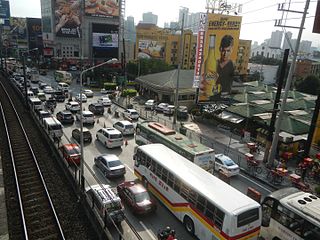
Trafficking in Metro Manila, based on the 2015 Global Satisfaction conducted by Waze, Metro Manila has the "worst traffic on Southeast Asia". Based on the 2015 Census of population by the Philippine Statistics Authority, the highly urbanized cities of Metro Manila were listed as being some of the densest cities in the world.

Pakistani craft has a long tradition and history. It is a traditional work or art of Pakistani people to produce, design or shape objects by using simple tools or simply by hand. It is generally produced by an individual, group or independent artists, and while it is an ancient custom, artists process traditional craft material such as brass, wood, clay, textiles, paper, or other embroidery material to create handmade items. Stone carving, sandstone, onyx, metalwork, pottery, and ajraks are commonly used techniques and materials to work upon handicrafts.




















